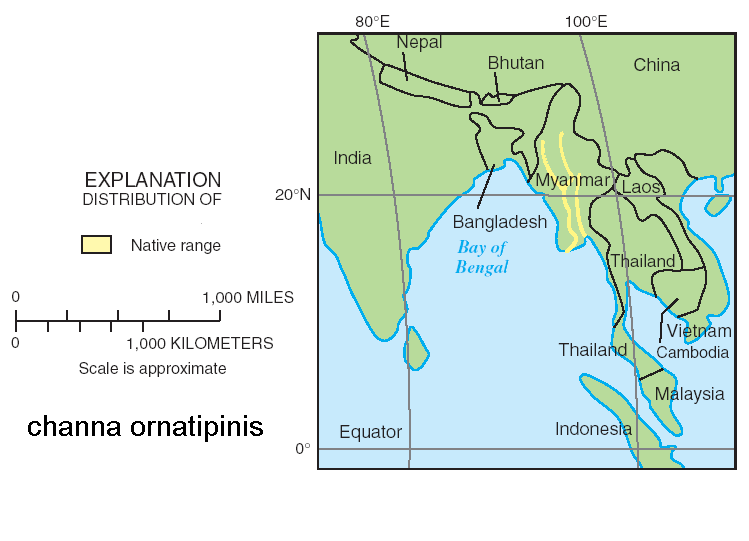updated 12th nov. as this fish is becoming more available
Species name: Channa ornatipinis
Common name: burmese spotted snakehead
Maximum size: around 25cm
Origin: Southern: Irrawaddy and Sitang River basins Myanmar

introductions: none as yet!!
Temperament: very aggresive , will not tolerate members of its own kind in small spaces , although a dwarf species req,s a very large well structured tank to house a group
Company: best kept in a species tank , do not mix with tropicals as these are sub-tropical fish and will not fair well , more than any other snakeheads these guys deserve propper consideration when buying. they deserve a species tank, and should be left to the more seasoned snakehead keeper. they do not make a very good 1st 2nd or even 3rd snakehead
Water parameters: Temperature 18-25 c ; pH avoid extreams, slighly softer water , although these guys can stand higher levels of temp for periods of time they sould not be kept year round at theese temps. there behavior is directly affected by tempreture , and very high temps are thought to be stressfull
Identification: similar to pulchra but have much more prominent black spots on head , allways shows multi black spots in dorsal fin
tank set-up: an important consideration for theese guys , even though they are considered as a dwarf species , please aquascape as if they where at least a medium sized snakehead , they are ultra aggresive amoung each other and need there own terratories , in nature they are found one large stones , one stone one fish - never two . try and replicate this in the aquarium with seperate areas for each fish , this in its self reqs, a large area to work with. where they are found the river bed is made up of volcanic rock (red lava) use of theese and plants can make a realistic biotope setting. temp should be sub-tropical with a lower safe guard set at around 16deg ambient temps should take care of the higher temps
as with pulchra they inhabit a stream that is fed from the hiymalaya mountains , in the wet season it is very wet with snow melt from the mountain causing fast flowing waters high oxogen content and higher ph values, in the drt season the opostite happens , streams dry up snow stops melting , so the stream turns into a series of isolated pools , in theese pools the oxogen content slowly drops as does ph and water level , in the aquarium this can be replicated by installing a sio, tunze ect powerhead at the surface during winter months , when summer comes round we can drop the level of the water ,turn off the pumps at the surface and add hardwood leaves to soften the water , by mimicing nature in this way we stand the best chance of getting these wonderfull fish to breed in aquaria , and also ensure they are at there happiest
other notes: they are from a small area and not very many are thought to live in the wild , they have not yet bred in the aquarium together with falling prices this is without doubt going to be putting excesive pressure on wild stocks , before we know it there will be no more left!!
as the prices have fell this has unfortunatly meant that they are available to more people and more people will but these fish as an impulse buy ,many of them are dieing at the hands of people who know no better , every owner of this fish should try and breed it to try and ensure the contunuance of this fish not only in aquariums but also in the wild
this fish is now to be found for around £20 each , only 1 year ago it comanded prices of £150 and up . although it is found quite often in shops i would urge you you leave it there unless you are perpered to meet this fishes needs
breeding: not yet acheived in the aquarium . thoughts are that following there natural pattern will be the key with this species , know to be a mouthbrooder from a male specamin caught in the wild carrying young.
some people have opted to keep theres in seperate aquariums while they grow . bringing them together when sexually mature , to save on deaths from fighting while growing up





